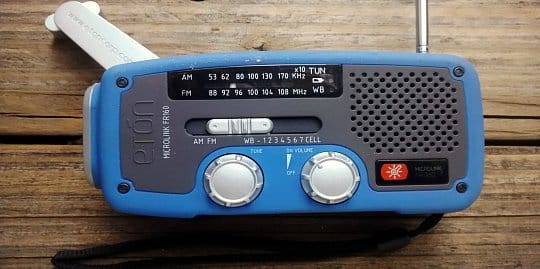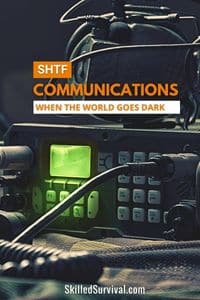
Because preparing for SHTF is more than just stockpiling food and water. It must include SHTF communications as well.
Being able to send and receive critical info (in real-time) about what’s happening…
So today, let’s review ALL your emergency radio options & which ones are BEST and WORST…
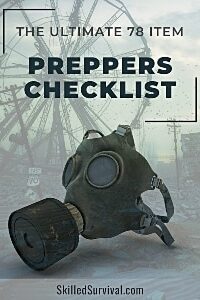
Want a free 78 item preppers checklist?
Enter your email below to instantly download this Complete Checklist PDF. No purchase necessary. 👇 👇Let’s Start With Cell Phones
Almost everybody today has a cell phone that can make calls and send text messages. And they are the best option for limited event emergencies. If you get in a car wreck, a cell phone works quickly to call for help.
A cell phone can notify medical professionals immediately if someone has a heart attack. Yet, they are just about the worst option for anything larger in scope.
Anybody who has been in a mass disaster situation can attest to the frustration of trying to make a cell phone call. They probably discovered that the network they are so used to using is completely overloaded and jammed. No outgoing calls, no incoming calls. Nothing.
Even at non-emergency events, such as popular at college football games, you’ll notice jammed cell phone networks locally.
This is especially true since nearly all college-aged adults are heavy cell phone users, and these types of cell phone network jams are common. And with the proliferation of smartphones, these local network jam-ups will likely get worse and more frequent.
A network jam is a common problem and is the cell phone’s Achilles heel. Making it the absolute worst communication option for SHTF. Even smoke signals will be more reliable than cell phones when SHTF.
↓ Getting emergency alters to cell phones is an imperfect system.
The one saving grace for cell phones is the text messaging option. Try using text when a mass emergency occurs and cell towers are jammed. The use of text messaging has proven to be slightly less affected by an emergency.
During Hurricane Katrina, text messaging (while not instant) did continue to get through. So, hey, it’s worth a shot. And with cell phones in rural areas of our country, you have to deal with weak cell phone signals.
Sure, you can get a cell phone signal booster, but those only work if there’s a signal to boost – not a guarantee in a widespread emergency. So, never make a cell phone your only survival communications option.
What about Hand Held Walkie Talkies?
Walkie-talkies, or GMRS/FRS radios, are great for short-range SHTF communications. They work best for a small individual group like your survival coalition. They don’t work for mass communication or long-range communications.
It’s an ideal option for a family wanting to stay in contact as they move around a small property or local area. Just be aware depending on the model and manufacturer, you’ll get different ranges. So make sure you test their range before you need them so you understand your walkie-talkies range limitations.
Most specified ranges are for flat open land areas. Trees, hills, and buildings tend to diminish the overall range. So remember this if you choose walkie-talkies as your local SHTF communication device.
↓ High Power SHTF Walkie-Talkie
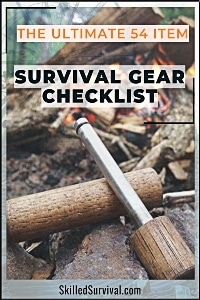
Want a free 54 item survival gear checklist?
Enter your email below to instantly download this Complete Checklist PDF. No purchase necessary. 👇 👇Are Ham Radios Good For SHTF?
Ham radio was one of the most popular communication devices over large distances in the middle of the 20th century. However, as phone networks improved, the cost of long-distance and international calls grew cheaper.
So the popularity of ham radio dwindled for the masses. But, HAM is perfect for survival purposes.
Ham radio networks are both reliable and can communicate over long distances. They are also not dependent on cell phone towers. The only real drawbacks to ham radio are the equipment costs and the training necessary to learn how to use it.
↓ Mike Glover Talks Ham Radio and Preparedness
You must get an official license if you intend to broadcast (and not just listen). An operator must obtain a license to operate ham equipment legally. This includes passing a test and paying a small fee.
↓ How to Easily Get Your HAM Radio License: a Beginner’s Guide
However, a license is not required to purchase, own, and listen in. Which is extremely valuable in most survival SHTF communications scenarios. And after SHTF, all these rules and regulations won’t matter anyway.
Plus, getting a small setup and a license is easy. So don’t let it stop you from becoming a licensed operator. Also, invest in upgrading your ham radio’s antenna so that you can transmit and receive signals over longer distances.
Getting intelligence reports from other States can prove very helpful when grid power is out nationwide due to an EMP attack.
Is CB Radio a Viable SHTF Communications Option?
Citizens Band radio was one of the most popular ways of keeping in contact with people in the 1970s and 80s. However, this form of communication dropped in popularity in the late 20th century.
CB’s advantages include the greater range vs. walkie-talkies. However, a CB radio is generally located in a single location within a property.
Within a built-up area, the use of CB radio could be affected by larger buildings and more interference. Unlike ham operators, CB operators don’t require a license or pass a test to use the airwaves.
↓ Communications Options For Preppers
Should I Invest in Listen-Only Devices?
One major problem when disaster strikes is the loss of power. All the devices discussed thus far require electrical or battery power to operate. So you’ll need to figure out your backup power system to operate these for longer periods of time when SHTF.
That’s why I suggest you invest in a listen-only device.
Not only are they low cost, but you can also get one with a hand crank to be able to keep it powered easily. Just crank and listen. Simple.
↓ Hand Crank Radio Review – Eton Microlink
These shortwave listen-only radios can provide an invaluable link to SHTF news. It can help keep you up to date on the current situation for any major disaster.
Another listen-only option to consider is the use of a police scanner. These allow you to obtain information that could be life-saving during an SHTF event. This is a unique option, as important news will be broadcast over analog police frequencies. But, many law organizations are moving to digital technologies.
So, over time, this option will become less effective.
Also, note that a scanner must be programmed in advance. You want to ensure you are tuned into the right channels to gain the right emergency news.
↓ A Budget-Friendly Tactical SHTF Comms Setup
SHTF Radio Action Plan
You should make a plan for all 3: Listen-Only, Local, and Long Range. These are the 3 communication levels you should strive for in your SHTF communications.
That way, even if you’re literally “in the dark,” your communications are NOT. This means a 3 pronged approach:
1. Listen Only
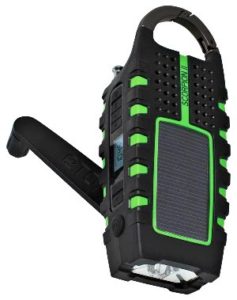
It’s small and lightweight (so it will fit in your Bug-out Bag), and it doesn’t require batteries. Done? Good, you now have your electrical independent SHTF listen-only communication taken care of.
Congrats!
2. Local Communication
The second is local communication. If you have a local survival coalition (and you should), then every member must have a walkie-talkie.
Now your coalition just got 10 times stronger as you can communicate much better and faster when SHTF.
3. Long-Range Communication
Finally, you should investigate owning and operating a ham radio. Here’s a good one to get you started and a website to learn more about getting a license.
For a true SHTF event, you’ll want to be able to reach out over longer distances to communicate with other survivalists and preppers. Good SHTF communications are a difference-maker in survival.
Listening and communicating locally and over long distances is vital to long-term survival success. Don’t underestimate this advantage.
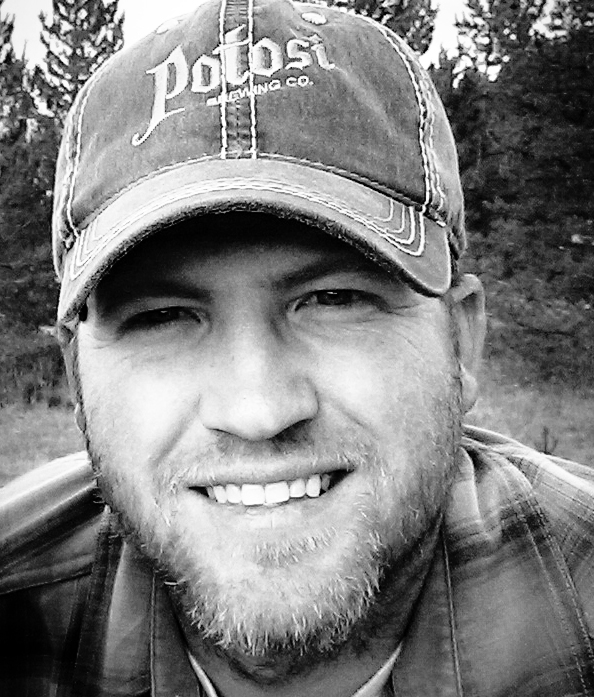
Prepare, Adapt & Overcome,
P.s. - I just found out 2 out of 3 Americans don’t feel prepared for a 3 day disaster!!!
I guess this goes to show how modern society continues to embrace ‘living a fragile life.’ What’s crazy is… it’s so easy to fix.
To make sure YOU have the basics, watch our FREE training on “10 Simple Steps To Basic Preparedness” that shows you HOW.
Nothing crazy here… this isn’t doomsday prepping... just the basics every responsible adult should have before a disaster strikes.Why You Can Trust Skilled Survival...
Go here now to review a full breakdown of:
- Who We Are
- Our Credentials
- Our Mission
- & Product Recommendations...
Here are a few highlights of our teams credentials & certifications:
- Certified Member of a Mountain Search & Rescue Organization
- Plant Emergency & Safety Leader for a Major Food Manufacturer
- Member of the 10TH Mountain Division Hut Association
- Certifications: Avalanche 1, WFR, CPR
- Official Gear Tester for Numerous Outdoor Gear Companies
- Countless Multiday Backpacking trips into Remote Wilderness
- Bachelor's Degree In Mechanical Engineering
- Bachelor's Degree In Civil Engineering
- Bachelor's Degree In Biomedical Engineering
"It takes 20 years to build a reputation and five minutes to ruin it." - Warren Buffett
We're fully aware that trust is NOT something you GET but is EARNED.
And we'll continue to earn YOUR trust through our forthright and honest approach with each new Blog Post, Guide & Product we create...
P.s - I just took this FREE 60-second 'Readiness Score Quiz'👇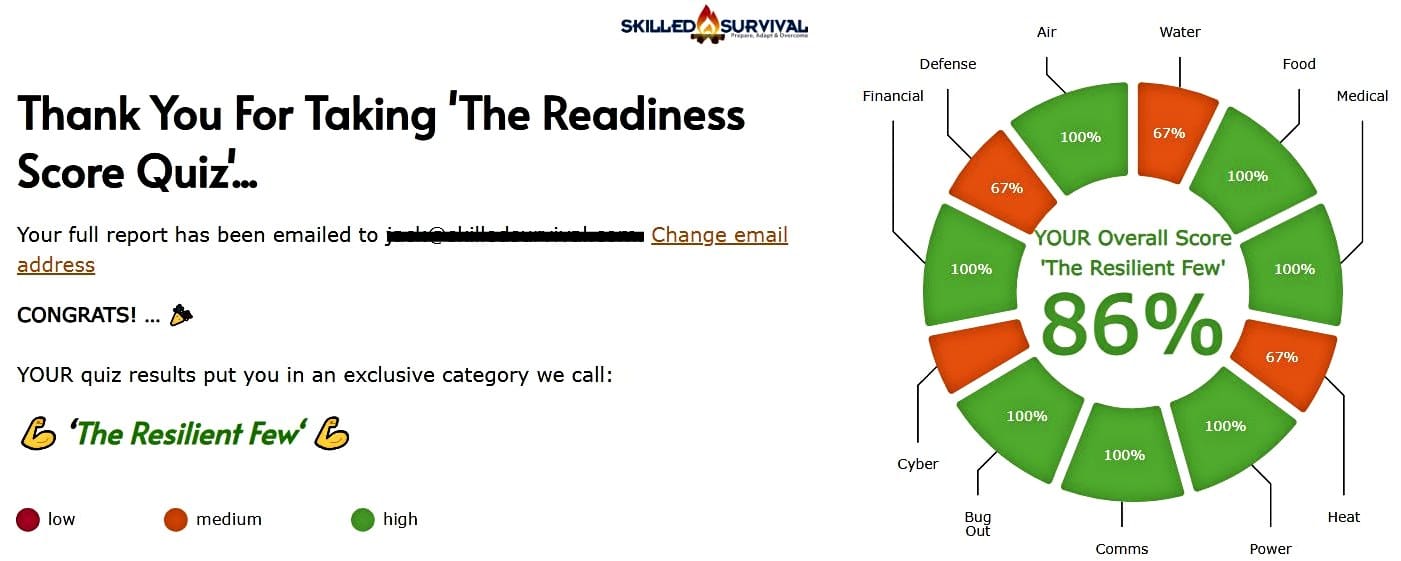
AND... I've still got a few gaps in my preps...🤔 But at least, I'm not part of 'The Fragile Masses'. 👍 Find out where YOU stand by answering a few questions...

Recommended Reading
Long Term Fuel Storage For Survival Emergencies
Long term fuel storage is crucial in emergencies, but fuels must be stored properly especially long term gasoline storage.
How To Store Seeds For Wise Prepping & Survival
When seed saving and seed storage, you must do it right. Learn how to store seeds so they'll thrive the next planting season.
Common Everyday Carry Mistakes YOU Must Avoid At All Costs
The only person qualified to build YOUR Best Everyday Carry (EDC) is YOU. To do it right, you must avoid these common mistakes and pitfalls.
Strategic Relocation: How To Find A Safe Pace To Live
Use strategic relocation to find a safe, defendable location to call home. Your choice of location WILL determine your survival fate.
Nuclear Fallout Map: Would I Survive A Nuclear Bomb?
Have you seen this nuclear fallout map? Or run a nuclear simulation to see the damage a nuke would do to your city? If not, check this out.
Homestead Survival: How To Master Plan Your Safe Haven
Use this simple 6 homestead survival plan to successfully survive (and thrive) even if the world falls into chaos...




